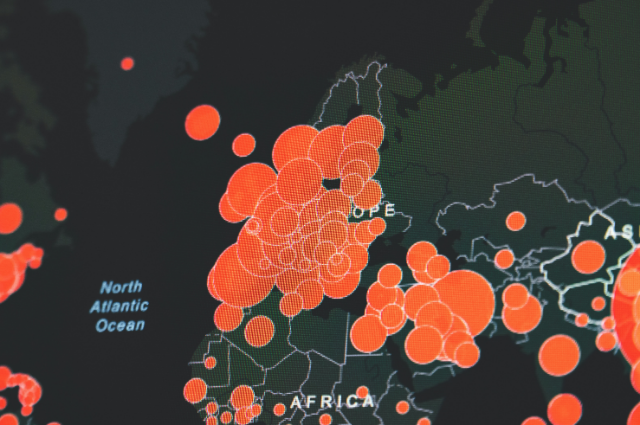
"Supply chains are the lifeblood of global commerce and the bedrock of modern economies." - Brian S. Dempsey"
CAUSES OF RECENT SUPPLY CHAIN DISRUPTIONS
- Geopolitical Tensions: Global supply chains are intricately linked across borders, making them highly sensitive to political dynamics. Trade wars, sanctions, and diplomatic conflicts can disrupt the flow of goods and materials, leading to delays, increased costs, and uncertainty in supply chain operations. For instance, ongoing tensions between major economies often result in tariff impositions, which can cripple entire industries reliant on cross-border trade.
- Pandemics and Public Health Crises: The COVID-19 pandemic starkly revealed the vulnerability of global supply chains to widespread health emergencies. Lockdowns, labor shortages, and factory shutdowns created bottlenecks that rippled across the globe. Just-in-time manufacturing models were particularly hard hit, as the sudden halt in production led to cascading effects on inventories and distribution networks, disrupting the availability of essential goods.
- Natural Disasters: Earthquakes, hurricanes, floods, and other natural disasters can wreak havoc on supply chains, especially in regions heavily dependent on a single geographical area for manufacturing or logistics. The 2011 Fukushima disaster in Japan, for example, caused significant disruptions in the automotive and electronics industries, as key component suppliers were unable to operate, leading to global shortages.
- Cyber Threats: In our increasingly digital world, cyber-attacks pose a significant threat to the integrity of supply chains. Cybercriminals can infiltrate systems, causing operational shutdowns, data breaches, and financial losses. The 2017 NotPetya attack, which paralyzed the operations of shipping giant Maersk, underscores how a single cyber incident can disrupt global trade and expose the fragility of interconnected supply chain systems.
These factors, individually and in combination, illustrate the complex and interconnected nature of global supply chains, highlighting the importance of proactive strategies to mitigate risks and ensure resilience in the face of such disruptions.
IMPACT ASSESSMENT ON GLOBAL TRADE
Economic Losses and Revenue Declines
The ripple effects of supply chain disruptions have led to significant economic downturns across multiple sectors. With factories unable to operate at full capacity due to material shortages, businesses have seen substantial declines in revenue.
This has been particularly evident in industries heavily reliant on just-in-time manufacturing, where even minor delays can result in considerable financial losses.
Increased Costs and Inflationary Pressures:
The scarcity of critical components and raw materials has driven up costs, leading to inflationary pressures globally. For instance, the semiconductor shortage has not only slowed down production in the automotive and electronics industries but has also pushed up the prices of finished goods, burdening consumers and businesses alike.
Extended Lead Times and Delivery Delays:
Disruptions have caused unprecedented delays in product delivery, with lead times extending from weeks to months. This has particularly affected industries like retail, where timely product availability is crucial. The unpredictability of shipments has forced companies to rethink their inventory strategies, often leading to overstocking or stockouts.
Operational Challenges and Supply Chain Bottlenecks:
Industries have faced operational hurdles, from labor shortages to transportation bottlenecks. Ports have been congested, and the lack of available shipping containers has exacerbated delays. These challenges have strained global trade routes, making it difficult for companies to maintain smooth operations and meet demand.
Shift in Global Trade Dynamics:
The disruptions have prompted a reassessment of global trade practices, with many companies reconsidering their reliance on global supply chains. There has been a noticeable shift towards regionalization, where businesses are looking to source materials and produce goods closer to their markets to mitigate the risks associated with long, complex supply chains.
LESSONS LEARNED FROM RECENT DISRUPTIONS

Redefining Supply Chain Visibility:
The COVID-19 pandemic underscored the critical importance of real-time visibility across the supply chain. Companies have learned to invest in digital tools like AI and IoT to monitor and manage inventory, track shipments, and foresee potential disruptions.
Enhanced visibility allows for quicker decision-making and more agile responses to unforeseen challenges.
Diversification of Suppliers and Manufacturing Bases:
Reliance on a single region or supplier proved to be a significant vulnerability during the pandemic. Companies have adapted by diversifying their supplier networks and expanding manufacturing bases across multiple geographies.
This strategy reduces the risk associated with localized disruptions and enhances the ability to maintain operations during crises.
Emphasizing Flexibility and Agility:
The need for flexibility has become paramount. Companies have shifted from just-in-time inventory models to more flexible approaches, such as maintaining strategic stockpiles of critical components and adopting modular production techniques.
This adaptability enables businesses to pivot quickly in response to supply chain interruptions.
Strengthening Supplier Relationships:
The disruptions highlighted the value of strong, transparent relationships with suppliers. Companies have focused on building more collaborative partnerships, fostering open communication, and engaging in joint risk management.
By working closely with suppliers, businesses can better anticipate challenges and co-create solutions.
Government Collaboration and Regulatory Adaptation:
Governments played a crucial role during the pandemic by enacting policies to support supply chain continuity. In response, companies have learned to engage more proactively with policymakers, advocating for regulatory flexibility and emergency support mechanisms.
This collaboration has become a vital component of risk management, ensuring that businesses can navigate future disruptions with the backing of supportive government policies.
BUILDING RESILIENCE IN SUPPLY CHAINS

1. Diversification of Suppliers:
- Mitigating Dependency Risks: Spread procurement across multiple suppliers across different regions to reduce dependency on a single source.
- Balancing Costs and Reliability: Choose a mix of local and global suppliers to balance cost-effectiveness with reliability, ensuring a continuous supply even in crisis situations.
- Supplier Redundancy: Establish backup suppliers for critical components to ensure quick transitions during disruptions without halting production.
2. Investment in Technology
- Automation and AI: Implement advanced technologies like AI and machine learning to predict potential disruptions and automate responses, enhancing decision-making speed.
- Real-Time Monitoring Systems: Deploy IoT-enabled tracking and monitoring systems for real-time visibility across the supply chain, enabling swift action in case of anomalies.
- Data Analytics for Forecasting: Use big data analytics to forecast demand fluctuations and supply chain vulnerabilities, allowing proactive adjustments.
3. Fostering Stronger Relationships with Stakeholders
- Collaborative Partnerships: Develop deeper collaborations with suppliers, logistics providers, and other stakeholders to ensure mutual understanding and support during disruptions.
- Transparency and Communication: Maintain open and transparent communication channels with key partners, fostering trust and ensuring everyone is aligned on contingency plans.
- Joint Risk Management Strategies: Work with stakeholders to create joint risk management strategies, sharing resources and knowledge to enhance collective resilience.
4. Flexible and Agile Supply Chain Models
- Adaptive Inventory Management: Adopt just-in-time (JIT) and just-in-case (JIC) inventory strategies depending on the risk environment, allowing for flexibility in inventory management.
- Modular Supply Chains: Design supply chains that can be quickly reconfigured to adapt to new circumstances, such as shifting production to different locations or switching suppliers rapidly.
- Scenario Planning: Regularly conduct scenario planning exercises to anticipate potential disruptions and prepare adaptive strategies that can be implemented quickly.
5. Sustainable and Ethical Sourcing
- Ethical Sourcing Practices: Prioritize suppliers who adhere to sustainable and ethical practices, ensuring long-term viability and reducing risks associated with unethical practices.
- Environmental Resilience: Consider environmental factors when selecting suppliers, opting for those with strong environmental management systems to withstand climate-related disruptions.
- Community Engagement: Engage with local communities where suppliers operate, investing in their development to create a stable socio-economic environment, further stabilizing the supply chain.
FUTURE OUTLOOK AND RECOMMENDATIONS
- Embracing Digital Transformation: The future of global supply chains lies in digital innovation. Businesses must adopt advanced technologies like AI, blockchain, and IoT to enhance visibility, streamline operations, and predict disruptions before they occur.
- Prioritizing Sustainability: Environmental concerns are reshaping supply chains. Companies that prioritize sustainable practices—reducing carbon footprints, sourcing ethically, and adopting circular economy principles—will not only mitigate risks but also align with consumer expectations and regulatory demands.
- Diversification of Suppliers and Markets: Reliance on a single supplier or region has proven risky. Future-ready businesses will diversify their supplier base and explore emerging markets to reduce dependency and build a more resilient supply network.
- Agile and Flexible Operations: The ability to pivot quickly in response to unexpected events is critical. Companies should invest in agile supply chain models that allow for rapid adjustments in sourcing, production, and distribution strategies.
- Strengthening Collaboration and Partnerships: Building stronger relationships with suppliers, logistics providers, and even competitors can create a more cooperative ecosystem. Collaboration will be key in sharing resources, knowledge, and strategies to weather future disruptions together.
CONCLUSION
In conclusion, the global supply chain landscape is evolving rapidly, driven by technological advancements, environmental concerns, and the need for greater resilience. As businesses navigate this complex terrain, the ability to adapt, innovate, and collaborate will be paramount.
By embracing digital tools, diversifying resources, and prioritizing sustainability, companies can not only mitigate future risks but also seize new opportunities in an increasingly interconnected world.
The challenges are significant, but with foresight and strategic planning, the future of global supply chains holds the promise of greater agility and strength.

